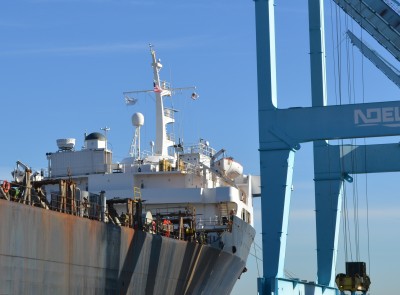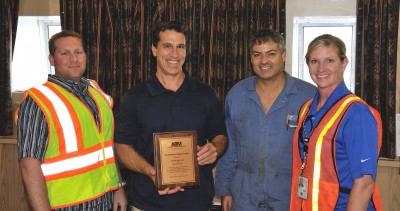MAGIC Takes a Bow
Published: 7 November 2013

As the Horizon Spirit sailed into port in Los Angeles at the end of September, the U.S. Department of Energy’s ARM Climate Research Facility notched another milestone for climate science. In obtaining nearly a year’s worth of atmospheric measurements while crisscrossing the Pacific Ocean, ARM’s second mobile facility, or AMF2, completed the first-ever full-scale deployment of scientific instrumentation on board an operating container ship.
“We want to express our sincerest gratitude to Horizon Lines. Their generosity in allowing us aboard their ship is unprecedented,” said AMF2 site manager Nicki Hickmon, a meteorologist at DOE’s Argonne National Laboratory. “The AMF2 team is thankful for the opportunity to execute this field campaign and are excited to see the shift in gears—analyzing and gaining results, which gives our efforts purpose and lasting meaning.”
Hickmon is referring the Marine ARM GPCI Investigation of Clouds, or MAGIC, field campaign, which began last October. This endeavor, proposed and led by scientist Ernie Lewis of DOE’s Brookhaven National Laboratory, resulted in a comprehensive data set of clouds, aerosols, precipitation, energy, and other meteorological variables measured during transects—or “legs”—between Los Angeles and Honolulu.
Scientists will use these data to study the formation of marine clouds and transitions among different types along this transect of the Pacific. The knowledge they gain will be used to improve the way these processes are represented in climate models.
Plans to use the data are already in progress, as described in this update from Lewis in the ARM Field Notes Blog. Some preliminary findings, including a surprising variability in the abundance of aerosol particles measured from one leg to the next, are described in this BNL feature article.
What Goes Up, Must Come Down

The AMF2 was designed to be modular for the very reasons illustrated by this campaign; space on the deck of a ship is not flexible. To deploy the suite of more than two dozen sensitive instrument systems—many of them updated with specialized engineering and software to account for “ocean motion”—plus instrument shelters and ancillary equipment, the AMF2 team worked closely with the Horizon Lines crew every step of the way.
To avoid impeding their cargo business, welding of the supporting instrument framework onto the working vessel’s deck had to be scheduled around port operations. This sometimes meant working through the night and into the early morning hours, before port activities kicked into gear.
The AMF2 team followed the same procedures in reverse to remove the instruments and footings in October. Hickmon happily reported an “uneventful” uninstall and deck remediation. To mark the occasion, she presented the ship’s captain with a plaque of appreciation for their unwavering support and participation.
With their MAGIC act in the books, the AMF2 team is busy preparing for another sea voyage—direct to Finland. Beginning in January, the mobile facility will operate from a Scots pine forest to obtain measurements for the Biogenic Aerosols-Effects on Clouds and Climate field campaign, a collaboration with Finnish scientists.
The ARM Climate Research Facility is a DOE Office of Science user facility. The ARM Facility is operated by nine DOE national laboratories, including .
Keep up with the Atmospheric Observer
Updates on ARM news, events, and opportunities delivered to your inbox
ARM User Profile
ARM welcomes users from all institutions and nations. A free ARM user account is needed to access ARM data.


















